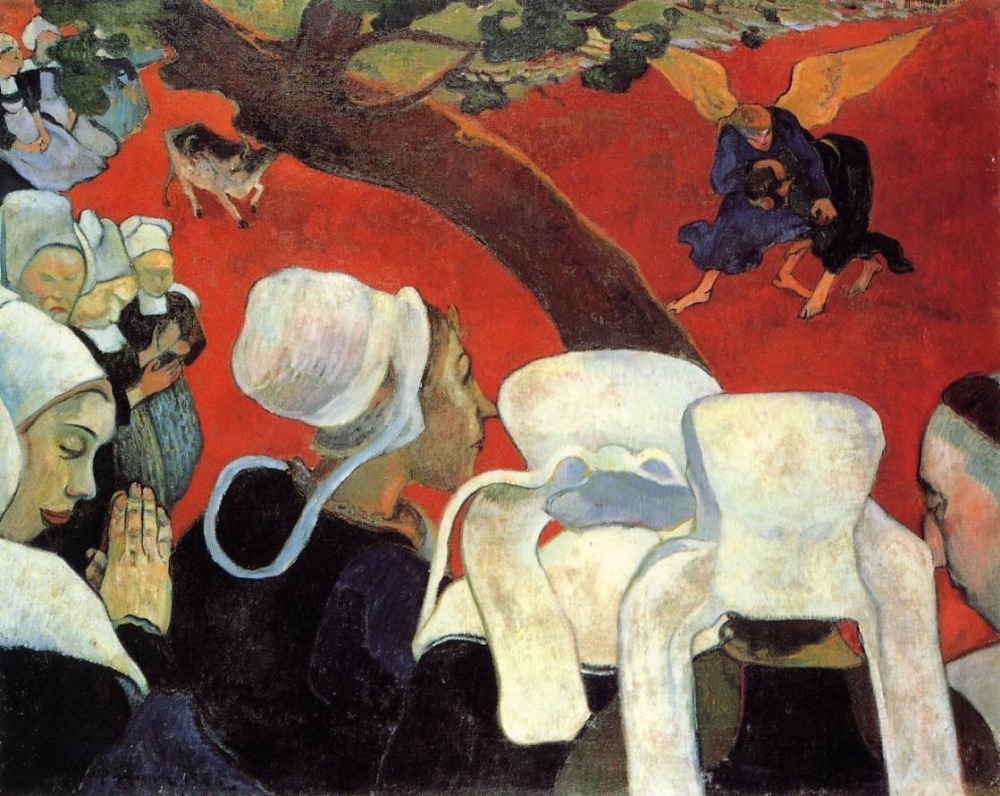A bustling
crowd is like an absorbent sponge, sucking water in and out. It should be
appreciated if disciplines and orders suddenly come in the way, and each
restless, abandoned entity is made to march in straight lines, shedding the
disguise of inapt boisterousness and simulating a performance of solemnity.
This orderly crowd resembles piles of clouds that occupy the sky: rarely is
there a prodigal son wandering off the group liberally. They always travel
together; as a family they should. People can divine no explanations when
seeing themselves constantly flanked by others of their kinds. The faces
bespeak stupor and insensitivity, but once a knell breaks every head looks up
in unquestionable promptitude.
The crowd
of devout religious believers merits a close inspection in Paul Gauguin’s Vision after the Sermon (1888). A
slender trunk of a tree diagonally separates the present scene with the
“vision”- the biblical scene of Jacob wrestling with an angel. Reality and
illusion coexist so harmoniously and almost imperceptibly on the same plane.
The colours, although grainy, do not show any sign of disintegrating like those
in a person’s faint remembrance, where everything will eventually peter out
with the smoke. These women in white do not wrangle or contend with the
confusion of the real and the novel, but simply closing their palms in
reverence- a placid disposition not dissimilar to a peaceful lake, where water
flows unconcernedly even when a leaf falls.
Blind
submission renders each member of the crowd a wooden doll. Any emotional
display seems like a jagged trigger of the doll’s limbs: ostentatious and
unnatural to a fault. For sure a tumult will ensue when silence and calm no
longer reign. The solidarity is still there amongst the crowd, but this time it
is predicated on the people’s irrepressible urge to rebel, fuelled by their
inner strife. In Otto Griebel’s The
International (1928) an imposing group of people, despite their
miscellaneous vocations, stand shoulder-to-shoulder as they belt out, presumably,
the song of the downtrodden. Rarely in Western art do we frequent upon
dauntless depictions of civilians in revolt. Mostly we are presented with the
aftermath of the remonstrance (the graphic violence of martyrdom) or the stasis
of those who are too sheepish to make a difference and preferring to while away
their lives with a hangdog look about them.
It is moot
whether the protestors will gain the upper hand. In a pessimistic light the
song they sing might be so thunderous that in the end it leaves no impression
on the superiors. But what they merit is the spectacle they create; as long as
there is a crowd the attention is on them. The orderliness of a crowd is
finally broken when attending a funeral, as seen in Gustave Courbet’s A Burial at Ornans (1849-50), some hang
their heads in bereavement, others shed tears like opened floodgates, but the
majority is stinted on exhibiting undue emotions. Blankness predominates.


Comments
Post a Comment